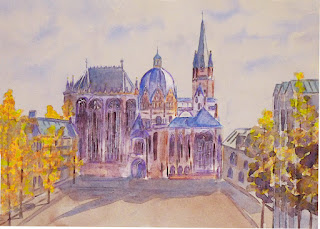 Europe
EuropeThe Cathedral of Aix-la-Chapelle in Aachen Germany is one of the oldest in Europe. Construction started in the late eighth century by order of Charlemagne. It was heavily damage in the ninth century by Vikings and restored in the tenth century. Originally Carolingian in style, with Gothic additions in the fourteenth and fifteenth centuries, the cathedral was heaviy damaged, and restored, in the twentieth century.
Americas & Pacific
Copan, in what is now Honduras, known as the Athens of the New
World, was founded in the fifth century and construction continued through the 700-year
Golden Age of Mayan Culture. The
Hieroglyphic Stairway shown here, which has enabled historians to decipher the
Mayan language, was completed in the eighth century.
The Dome of the Rock in Jerusalem is an example of Umayyad
architecture which developed in the Middle East in the seventh and eighth
centuries, at the beginning of Islam. Completed at the beginning of the eighth
century, the Dome was built on the Temple Mount, site of Herod’s Temple in the first century BCE and a subsequent
Roman temple in the second century CE, and may have been an addition to an
existing Byzantine building. It
collapsed and was restored after earthquakes in the ninth and eleventh
centuries, became a Christian church after the Crusaders captured Jerusalem at the
end of the eleventh century and was re-consecrated as a Muslim shrine in the
late twelfth century.
Asia
Meanwhile in the Far East, the Bulguksa Temple
was completed by the Court of Silla in the eighth century. Considered a masterpiece of the Golden Age of Buddhist art, the temple encompassses seven National Treasures of South Korea, including two stone pagodas, the Blue Cloud Bridge and two bronze statues of the Buddha.









